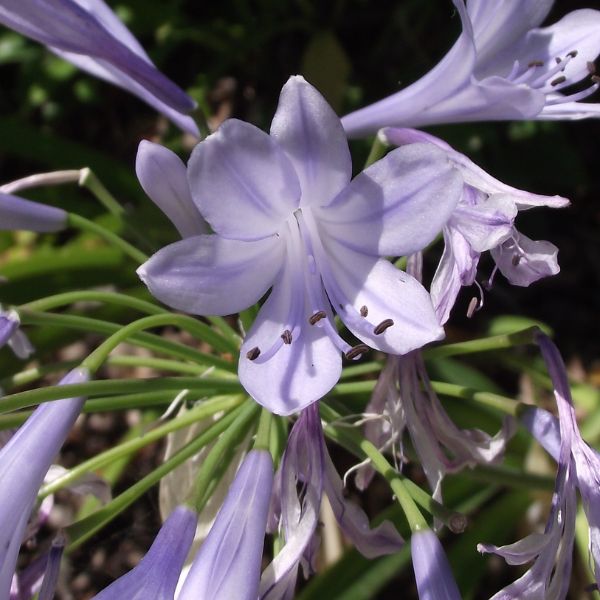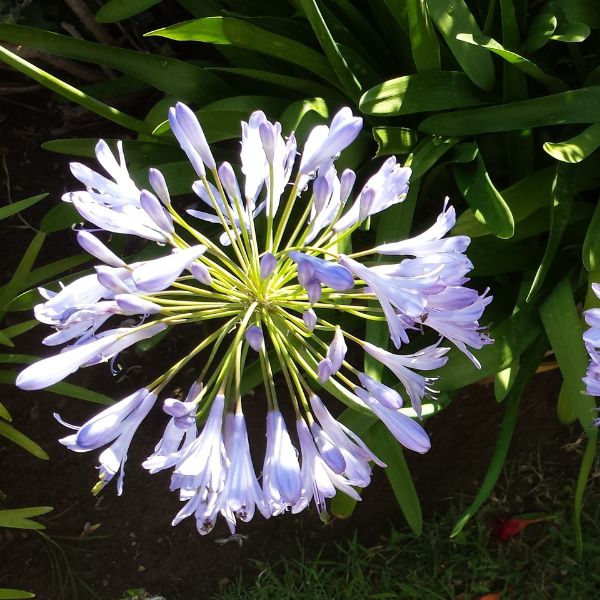Blue Yonder Lily of the Nile
Agapanthus 'Blue Wonder'
- Stay Protected with Plant Sentry ™
Blue Yonder Lily of the Nile - #1 Container is backordered and will ship as soon as it is back in stock.
Plant Sentry™
Plant Sentry™

Plant Sentry™ Protected
Your order is protected by our compliance system that:
- Prevents restricted plants from shipping to your state
- Ensures plants meet your state's agricultural requirements
- Protects gardens from invasive pests and diseases
Delivery and Shipping
Delivery and Shipping
Delivery and Shipping
Fast, Safe Plant Delivery
Ships in 3-4 business days • Tracking provided • Weather protected
| Under $50 | $9.99 |
| $50 - $99.99 | $14.99 |
| $100 - $149.99 | $16.99 |
| $150 - $198.99 | $24.99 |
| $199+ | FREE |
✓ Zone-specific timing • ✓ Professional packaging • ✓ Health guarantee
Understanding Plant Options
Nature Hills offers plants in two main formats:
- Container Plants: Grown in pots with soil, sized by container volume and plant age
- Bare Root Plants: Dormant plants without soil, sized by height measurements
Container Plant Sizes
Container sizes indicate plant age and growing capacity rather than liquid volume equivalents. Our containers follow industry-standard nursery "trade gallon" specifications, which differ from standard liquid gallon measurements.
Young Plants (6 months to 18 months old)
| Container Size | Actual Volume | Metric Equivalent |
|---|---|---|
| 2" x 2" x 3" | 0.18 - 0.21 dry quarts | 0.20 - 0.23 dry liters |
| 4" Container | 0.31 - 0.87 dry quarts | 0.35 - 0.96 dry liters |
| 4.5" Container | 0.65 dry quarts | 0.72 dry liters |
| 6" Container | 1.4 dry quarts | 1.59 dry liters |
| 1 Quart | 1 dry quart | 1.1 dry liters |
| 5.5" Container | 1.89 dry quarts | 2.08 dry liters |
Established Plants (18 months to 2.5 years old)
| Container Size | Actual Volume | Metric Equivalent |
|---|---|---|
| 2 Quart | 2 dry quarts | 2.2 dry liters |
| #1 Container | 2.26 - 3.73 dry quarts | 2.49 - 4.11 dry liters |
| 5" x 5" x 12" | 3.5 - 4.3 dry quarts | 3.85 - 4.74 dry liters |
Mature Plants (2-4 years old)
| Container Size | Actual Volume | Metric Equivalent |
|---|---|---|
| #2 Container | 1.19 - 1.76 dry gallons | 5.24 - 7.75 dry liters |
| #3 Container | 2.15 - 2.76 dry gallons | 8.14 - 12.16 dry liters |
Large Plants (3-5 years old)
| Container Size | Actual Volume | Metric Equivalent |
|---|---|---|
| #5 Container | 2.92 - 4.62 dry gallons | 12.86 - 20.35 dry liters |
| #6 Container | 5.25 - 6.01 dry gallons | 23.12 - 26.42 dry liters |
| #7 Container | 5.98 - 6.53 dry gallons | 26.34 - 28.76 dry liters |
Bare Root Plants
Bare root plants are sold by height from the root system to the top of the plant. Plants may exceed minimum height requirements.
Common Sizes:
- Trees: 1 foot, 2 feet, 3 feet, 4 feet, 5 feet, 6 feet
- Shrubs & Perennials: 1 foot, 18 inches, 2 feet
Important Notes
Container Volume Specifications
- Trade Gallon Standard: Our containers follow industry-standard "trade gallon" specifications established by the American National Standards Institute (ANSI Z60.1) for nursery stock
- Volume Variations: Actual soil volume may vary due to plant root systems and growing medium settlement
- Age Indicators: Container size primarily indicates plant age and maturity rather than liquid volume equivalents
Growing Conditions
- Plant size can vary based on variety and growing conditions
- Container size helps indicate plant maturity and establishment level
- Larger containers generally mean more established root systems and faster landscape establishment
Seasonal Availability
- Bare root plants are available seasonally when dormant
- Container plants are available throughout the growing season
- Specific varieties may have limited availability in certain sizes
Questions?
For questions about specific plant sizes or availability, please contact our plant experts who can help you choose the right size for your landscape needs.
Plant Highlights
Blue Yonder Lily of the Nile highlights at a glance!
-
Botanical Name
-
Brand
-
Growing Zones6, 7, 8, 9, 10
-
Growth RateModerate
-
Mature Height
-
Mature Width
-
Leaf Color
-
Flower Color
-
Pollinator FriendlyYes
-
Bloom PeriodEarly Summer, Late Summer
-
FragrantYes
-
Does Not Ship To
Characteristics
Where To Plant
When To Prune
- Late Winter
Water & Moisture Needs
- Moderate
Sunlight Needs
Soil Needs
- Well Drained

Growing Zones 6-11
Elegant and Exquisite Blue Yonder Lily of the Nile
- Brilliant Blue-Purple Florets
- Clusters Stand on Strong Stems
- Gorgeous Green Strapped Foliage
- Delightfully Fragrant
- Attracts Hummingbirds
- Gets Better With Age
- Increased Cold Hardiness
- Great for Mass Plantings
- Creates Texture in Gardens
- Lovely Container Plants
While the name would lead you to believe it's native to the regions around the Nile River, Blue Yonder Lily of the Nile (Agapanthus 'Blue Yonder') is actually from areas around South Africa.
It makes quite a bit more sense for this perennial to go by its other name, Blue Yonder African Lily. However, we weren't in the official Name That Plant meeting, so we'll stick with the Nile.
The color of this pretty flower will have you thinking about the cool, running water of a river. Each dainty floret is a graceful blue-purple combination. Altogether, it creates showy clusters of intense cobalt blue star flowers
These flower clusters form on top of sturdy stems that rise from the delightful narrow green strap leaves. It might be a delicate perennial, but it's worth the trouble as the plants begin blooming in late spring and continue to produce flowers into fall!
Blue Yonder gets better with age! Each year, it will produce more and more blooms per plant. Plus, this particular type of African Lily is more winter hardy than the average Agapanthus. So colder regions can enjoy the beautiful blue show.
Like other flowers with trumpet type blooms, Blue Yonder will periodically attract hummingbirds, along with the usual butterflies and other beneficial pollinators. Make sure you keep an eye out during peak bloom season!
Another perk this perennial offers is its fantastic fragrance! Planting a couple along your front path will put a smile on your guest's face before ever stepping in your home!
This is one plant you aren't going to want to miss. Fragrant, beautiful, and cold hardy, order a Blue Yonder Lily of the Nile today!
How to Use Blue Yonder Lily of the Nile in the Landscape
There are the classic uses for a stunning plant like this, and then there are the creative, thinking outside the box, uses. We're here for both of them!
Order a few and use them as periodic accents in your perennial flower beds. When in bloom, the flowers will be the perfect height to peak up behind front row plants without overshadowing the taller, back row plants.
This same principle applies to any cottage gardens you're in the process of perfecting. These unique flowers will fit right into even the quirkiest aesthetics.
If your flower beds are already spoken for, you can always plant Blue Yonder as a border specimen. Mix it with other colored perennials to catch the eyes of your neighbors passing by.
Due to the low to the ground green foliage and the shooting stems, planting this African Lily will for sure give you that little bit of extra texture you've been looking for!
Don't forget, Blue Yonder is extra fragrant as well. So try planting under a window or near your front and backyard pathways, where the sweet scent can lighten up your home and leisurely stroll.
Do you have a larger space to fill? Blue Yonder creates a powerful display when planted in mass!
If you live in the colder regions of this plant's hardiness zones, try planting in containers on either side of your entryway. That way you can overwinter them by moving them to a protected area like the garage.
#ProPlantTips for Care
Blue Yonder Lily of the Nile is sometimes considered a rather delicate perennial. But it's easy enough to take care of with the right knowledge.
The most important thing to consider when planting is the amount of light it will get and the soil it will be in. Full sun and rich, well drained soil are by far the best for this perennial, and in the warmer zones these plants will appreciate some midday reprieve from the sun.
If you live in zone 5, you might try planting in a container so that you can move into a porch or garage for the worst of winter. Then, in the early spring, you can move it back outside for its growing season.
It's always a good idea to mulch around the base of your plants. It'll help protect the roots from the worst of the heat and the cold. Not to mention it'll conserve water and keep the garden looking prim and proper.
Very little beats a mass of heavenly Blue Yonder Lily of the Nile. Don't go another season without, order yours from Nature Hills Nursery today!










